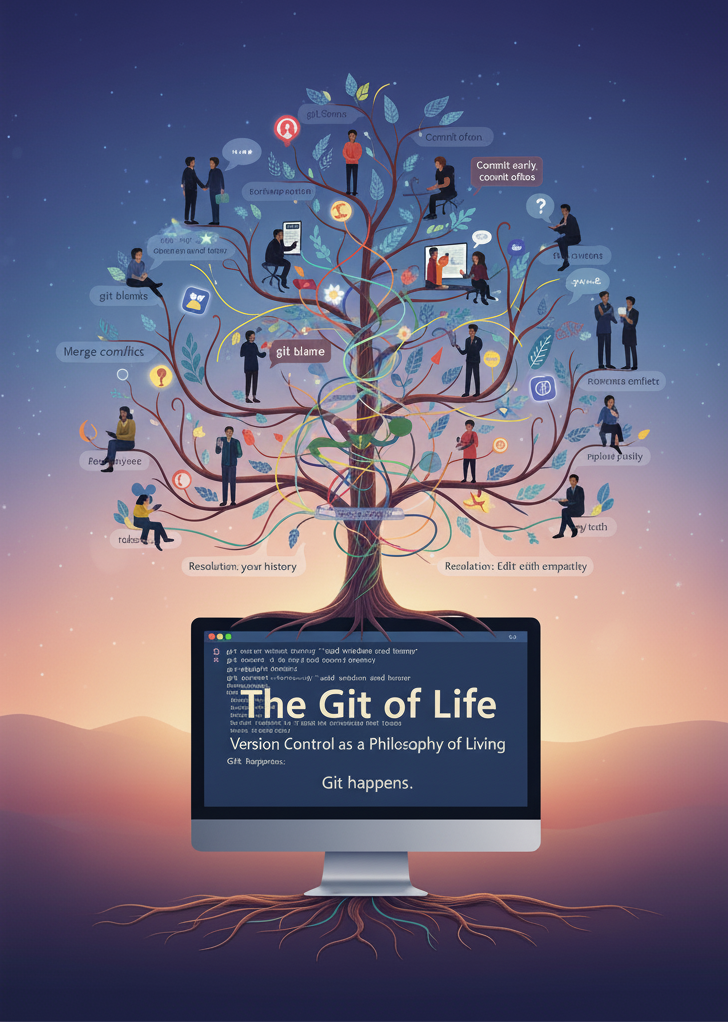Life might not come with a manual, but what if it came with version control?
Developers have Git to manage code. But Git is also a surprisingly deep philosophy of living — one filled with humor, structure, and wisdom about when to speak, when to stay quiet, how to collaborate, and how to recover from conflicts without --force.
🗣️ Speak or Save: Knowing When to Commit (and When to Push)
In Git, a commit is like a diary entry — deliberate, timestamped, and (hopefully) meaningful.
In life, it’s the same: don’t commit to every thought that pops into your head.
A clean commit history is like a clean conscience — both take effort.
Yet perfectionism is the real bug. Developers say:
Commit early, commit often.
Because small, consistent updates beat monumental, overdue gestures. Speak up in increments; life’s version control handles better that way.
And just as every commit needs a clear message, every word you speak deserves clarity. “Fixed stuff” doesn’t cut it in code or conversation. Express yourself precisely. You’re writing history — someone (likely you) will have to read it later.
Need to vent? Use life’s version of git stash.
Not every rant deserves a push to origin/main.
💬 The Log of Communication: Commit Messages & the Blame Game
Communication is the git log of relationships.
A thoughtful log tells a coherent story: who changed what, when, and why.
An unclear one reads like “who broke everything?”
And yes, git blame exists in both realms.
In code, it finds the author of a problematic line. In life, it’s called accountability — though we often misuse it as a weapon instead of a lesson.
The truth?
Good communication and good Git hygiene share the same rule:
Explain what you did and why — clearly, briefly, and without drama.
Pull requests are just conversations with structure.
Code review is diplomacy with syntax highlighting.
Life works better when we message, not monologue.
🌳 Branches and Forks: Collaboration and Independence
In Git, branches represent new ideas explored safely in parallel.
In life, each of us is a branch off the main trunk — experimenting, diverging, learning.
But healthy collaboration requires merging back.
Branch out to grow.
Merge back to belong.
Forking, on the other hand, is when differences become permanent.
Sometimes it’s creative independence — other times, it’s a clean breakup.
Just remember: even in forks, you still share common ancestry.
Sync occasionally. Pull updates. Don’t drift so far you forget the origin.
♟️ Checks, Balances, and the Democratic Pull Request
Every good team practices code review: no major change goes unexamined.
It’s democracy for developers — checks and balances enforced by git diff.
Two approvals before merge. Consensus before chaos.
In life, reviews look like:
- “What do you think of this idea?”
- “Does this sound okay?”
- “Please talk me out of this impulse purchase.”
Feedback saves you from self-inflicted bugs.
And yes, it stings — but so does a production outage.
Remember the sacred approval phrase: LGTM (Looks Good To Me).
We all crave that nod of recognition. It’s not just validation; it’s connection.
Life’s code is meant to be peer-reviewed.
🌀 Rebase, Cherry-Pick, Reset: Adapting and Evolving Your History
If Git has a spiritual side, it’s rebase.
Rebasing rewrites history. It makes messy development look linear — as if you always knew what you were doing. (We both know you didn’t.)
In life, rebasing is reframing.
You can’t change the past, but you can change the story you tell yourself about it.
Inertia — momentum can shift in an instant.
A single rebase of perspective can turn regret into growth.
Just remember Git’s cardinal rule:
Don’t rebase public history.
Once something’s public — a mistake, a post, a breakup — don’t pretend it never happened.
Instead, merge it. Integrate it into who you’ve become.
Clean up your local branch (your mindset), but don’t gaslight the repo (the people).
cherry-pick teaches another lesson: borrow the good parts.
Take a specific insight from someone else’s life and apply it wisely.
Just be careful — out-of-context commits can cause conflicts.
git reset? That’s a fresh start.
But do it softly — keep the lessons staged.
Hard resets erase growth, and there’s no undo in real life.
⚔️ Merge Conflicts: The Art of Conflict Resolution
Ah, merge conflicts — the unavoidable friction of teamwork.
Two people edit the same file, and Git politely says: “You two need to talk.”
Conflicts are just life’s way of flagging that two truths exist at once.
Resolution is editing with empathy:
- Read both sides of the diff.
- Keep what’s essential.
- Rewrite until it flows.
When it’s done, that message —
“This branch has no conflicts with the base branch.”
— feels like emotional nirvana.
It’s rare, magical, and totally worth the effort.
A conflict-free merge is basically a unicorn on a rainbow.
🪶 Final Commit: Insights from the Git of Life
Let’s git commit -m "add wisdom and humor":
- Commit to what matters — early and often.
- Write meaningful messages — clarity beats cleverness.
- Branch out boldly, but merge back humbly.
- Seek code reviews — feedback is how we debug ourselves.
- Rebase internally — grow, adapt, but don’t rewrite shared truth.
- Cherry-pick wisely — borrow ideas, not identities.
- Reset gently — refresh without erasing.
- Resolve conflicts with empathy — the diff is where truth hides.
Life, like Git, is an ever-evolving collaboration.
We each contribute commits, merge experiences, and refactor our stories.
Mistakes aren’t fatal — they’re just commits awaiting revision.
So branch out.
Commit your truth.
Push your growth.
And when in doubt —
Git happens.

Leave a Reply